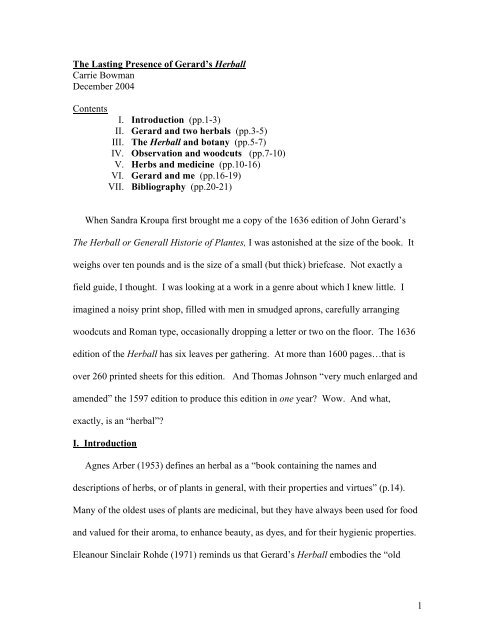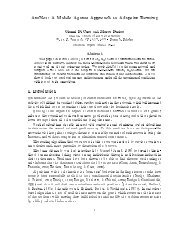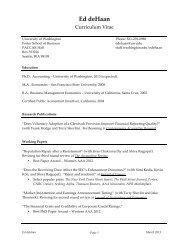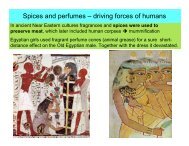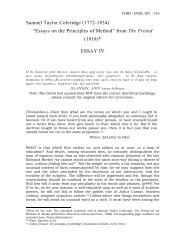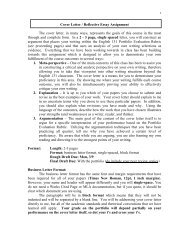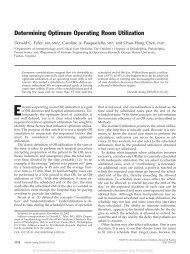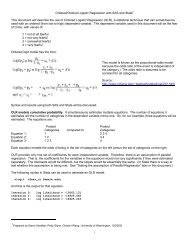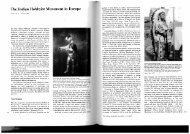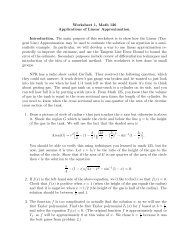The Lasting Presence of Gerard's Herball
The Lasting Presence of Gerard's Herball
The Lasting Presence of Gerard's Herball
Create successful ePaper yourself
Turn your PDF publications into a flip-book with our unique Google optimized e-Paper software.
<strong>The</strong> <strong>Lasting</strong> <strong>Presence</strong> <strong>of</strong> Gerard’s <strong>Herball</strong><br />
Carrie Bowman<br />
December 2004<br />
Contents<br />
I. Introduction (pp.1-3)<br />
II. Gerard and two herbals (pp.3-5)<br />
III. <strong>The</strong> <strong>Herball</strong> and botany (pp.5-7)<br />
IV. Observation and woodcuts (pp.7-10)<br />
V. Herbs and medicine (pp.10-16)<br />
VI. Gerard and me (pp.16-19)<br />
VII. Bibliography (pp.20-21)<br />
When Sandra Kroupa first brought me a copy <strong>of</strong> the 1636 edition <strong>of</strong> John Gerard’s<br />
<strong>The</strong> <strong>Herball</strong> or Generall Historie <strong>of</strong> Plantes, I was astonished at the size <strong>of</strong> the book. It<br />
weighs over ten pounds and is the size <strong>of</strong> a small (but thick) briefcase. Not exactly a<br />
field guide, I thought. I was looking at a work in a genre about which I knew little. I<br />
imagined a noisy print shop, filled with men in smudged aprons, carefully arranging<br />
woodcuts and Roman type, occasionally dropping a letter or two on the floor. <strong>The</strong> 1636<br />
edition <strong>of</strong> the <strong>Herball</strong> has six leaves per gathering. At more than 1600 pages…that is<br />
over 260 printed sheets for this edition. And Thomas Johnson “very much enlarged and<br />
amended” the 1597 edition to produce this edition in one year? Wow. And what,<br />
exactly, is an “herbal”?<br />
I. Introduction<br />
Agnes Arber (1953) defines an herbal as a “book containing the names and<br />
descriptions <strong>of</strong> herbs, or <strong>of</strong> plants in general, with their properties and virtues” (p.14).<br />
Many <strong>of</strong> the oldest uses <strong>of</strong> plants are medicinal, but they have always been used for food<br />
and valued for their aroma, to enhance beauty, as dyes, and for their hygienic properties.<br />
Eleanour Sinclair Rohde (1971) reminds us that Gerard’s <strong>Herball</strong> embodies the “old<br />
1
simple belief in the efficacy <strong>of</strong> herbs to cure not only physical ills, but also those <strong>of</strong> the<br />
mind and even <strong>of</strong> the heart” (p.105). I began to construct a picture <strong>of</strong> an enduring genre,<br />
for in the 21 st century, people grow, gather, and use plants for the same reasons.<br />
John Gerard is considered the most famous <strong>of</strong> the English herbalists. His herbal was<br />
carried to America and a copy owned by Dorothy Rolfe (mother-in-law <strong>of</strong> Pocahontas)<br />
now resides at Oxford (Gunther, 1922, p.57n2). As I poked around, I found an essay<br />
written about Gerard in the 19 th century. In the 20 th century, W.H. Hudson muses about<br />
Gerard and compares reading his <strong>Herball</strong> to “the delight <strong>of</strong> flowers themselves” (1932,<br />
p.49). <strong>The</strong> 1998 edition <strong>of</strong> Rodale’s Illustrated Encyclopedia <strong>of</strong> Herbs quotes Gerard and<br />
includes an entry about him.<br />
Opinions about Gerard, however, are not universally enthusiastic. Penelope<br />
Hobhouse, in Plants in Garden History (1997), introduces him unceremoniously, stating,<br />
“John Gerard has assumed an importance in England beyond his true significance”<br />
(p.105). Others have <strong>of</strong>fered similar pronouncements, and some facts provide<br />
justification for this point <strong>of</strong> view. For example, Gerard’s book is not the first printed<br />
herbal in the English language [that distinction is bestowed by Arber (1953, p.41) upon<br />
an anonymous quarto published by Rycharde Banckes in 1525]. In some ways Gerard’s<br />
work is not the most notable herbal <strong>of</strong> its period, either. <strong>The</strong> woodcut illustrations are not<br />
original to his work. And he has been accused <strong>of</strong> plagiarizing the text. Yet, most people<br />
asked to name an herbal will mention Gerard’s <strong>Herball</strong>.<br />
This paper is a study <strong>of</strong> the interesting fact that the <strong>Herball</strong> is known today (and has<br />
remained popular since its publication) in spite <strong>of</strong> its supposed shortcomings. I attempt<br />
to provide a context for the passage <strong>of</strong> the book from person to person for nearly 400<br />
2
years. I say “person to person” because I think that is the essence <strong>of</strong> the preservation <strong>of</strong><br />
this work. On the face <strong>of</strong> it, such hand-to-hand transfer is obvious and trivial. Yet, why<br />
and how does it occur? And what magic, if any, lies between the pages <strong>of</strong> Gerard’s<br />
<strong>Herball</strong>? Why have people pored over this herbal, shared it, talked about it, written about<br />
it, and hauled it into the woods?<br />
Edmund Gosse makes an astute observation in Gossip in the Library (1891) as he<br />
remarks on two characteristics <strong>of</strong> Gerard’s writing. Gerard is universally acclaimed for<br />
his skilled use <strong>of</strong> language and for his charming insertion <strong>of</strong> personal anecdote about the<br />
places where various plants can be found. <strong>The</strong> first characteristic is somewhat bound by<br />
time—most <strong>of</strong> us are unfamiliar with Elizabethan English and find it awkward to read.<br />
<strong>The</strong> second characteristic, on the other hand, is everlasting. Gosse mentions that he “was<br />
examining fresh varieties <strong>of</strong> auricular in ‘the gardens <strong>of</strong> Mr. Tradescant and Mr. Tuggie’<br />
[quoting Gerard]” (p.73). <strong>The</strong>n he remarks, “It is wonderful how modern the latter<br />
statement sounds…the garden seems the one spot on earth where history does not assert<br />
itself…” (pp.73,74). Gosse has noticed a thread stretching from Gerard into his time; we,<br />
the reader, can pick up the frayed end again in our own day. On that thread hangs the key<br />
to beloved garden writing: the sharing <strong>of</strong> personal observation. My intention is to<br />
explore the ways in which the sharing <strong>of</strong> personal observation figures in the lasting<br />
presence <strong>of</strong> Gerard’s <strong>Herball</strong>. I believe a blending <strong>of</strong> influence occurs, as people over<br />
the centuries have impacted Gerard’s work as much as the other way around.<br />
II. Gerard and two herbals<br />
John Gerard was born in Nantwich in Cheshire in 1545 and died in London in 1612.<br />
Most British herbalists were either physicians (barber-surgeons) or pharmacists<br />
3
(apothecaries); Gerard was a member <strong>of</strong> the Barber-Surgeons’ Company for much <strong>of</strong> his<br />
life. Rohde (1971) notes that we know little <strong>of</strong> the details <strong>of</strong> his life, but she and others<br />
point to his knowledge <strong>of</strong> plants and his gardening skill. He served as head gardener for<br />
Sir William Cecil Knight, Baron <strong>of</strong> Burghley, for many years, and was probably a well-<br />
known plant expert by the end <strong>of</strong> his life. He had his own garden in Holborn for twenty<br />
years, publishing a catalogue <strong>of</strong> his plants in 1596 (Rohde, 1971). This catalogue is one<br />
<strong>of</strong> the first known published lists <strong>of</strong> the plants in a single garden (Gunther, 1922).<br />
John Norton published the first edition <strong>of</strong> Gerard’s <strong>Herball</strong> in 1597. Norton<br />
commissioned a Dr. Priest to translate Dodoens’ herbal, Pemptades, from Latin into<br />
English, but unfortunately, Priest died before the translation was complete. Gerard<br />
picked up the project and finished with the help <strong>of</strong> Mathias de l’Obel, who was<br />
apparently more pr<strong>of</strong>icient in Latin. L’Obel corrected numerous mistakes—Gerard<br />
frequently mismatched the woodcut illustrations and botanical descriptions. <strong>The</strong>se<br />
efforts to complete Priest’s translation <strong>of</strong> Dodoens’ work are the source <strong>of</strong> much <strong>of</strong> the<br />
criticism <strong>of</strong> Gerard. He is accused <strong>of</strong> plagiarizing Priest (he gives Priest no credit in the<br />
introductory passages <strong>of</strong> the <strong>Herball</strong>). He is further criticized, rightly or wrongly, for<br />
lacking the requisite botanical knowledge to undertake the task <strong>of</strong> translation in the first<br />
place (Arber, 1953).<br />
According to Martyn Rix (1990, p.43), the 1597 edition <strong>of</strong> the <strong>Herball</strong> was a financial<br />
success. Perusing Arber’s Appendix I—a list <strong>of</strong> herbals and related botanical works<br />
published between 1470 and 1670—one can see that no English botanical works were<br />
published between 1597 and 1629, when John Parkinson’s Paradisi was printed. Perhaps<br />
the publication <strong>of</strong> a competing work prompted Thomas Johnson, a London apothecary<br />
4
and botanist, to undertake the project <strong>of</strong> updating Gerard’s <strong>Herball</strong>. R. T. Gunther (1922)<br />
credits one <strong>of</strong> the finest British botanists <strong>of</strong> the day, John Goodyer, with significant<br />
contribution to the effort. Goodyer “made the fullest use <strong>of</strong> the [1597] Herbal” and<br />
sometime between 1621 and 1622 he sent Johnson 27 pages <strong>of</strong> notes for inclusion in an<br />
updated edition. <strong>The</strong> first revision <strong>of</strong> Gerard’s work was published in 1633. (A second<br />
edition, unchanged, was published in 1636. I examined copies <strong>of</strong> both editions. I spent<br />
most <strong>of</strong> my time studying the 1636 edition and quote from it.)<br />
Historical claims that Johnson produced the revised edition by himself in a single year<br />
are probably exaggerated. More noteworthy is the collaboration between Johnson and<br />
Goodyer. <strong>The</strong> Hon. Mrs. Evelyn Cecil (1910) states, “It is refreshing to see the way in<br />
which [the] old herbalists wrote to each other, and helped one another. Johnson, even<br />
more than Gerard, worked in harmony with other botanists and physicians, and they went<br />
on expeditions together in search <strong>of</strong> rare flowers” (p.149). Johnson’s collaboration with<br />
Goodyer is an event highlighting the impetus for an improved herbal coming from the<br />
maturing science <strong>of</strong> botany.<br />
III. <strong>The</strong> <strong>Herball</strong> and botany<br />
<strong>The</strong> herbal tradition is closely tied to both the history <strong>of</strong> botany and the history <strong>of</strong><br />
medicine. As defined by Arber (1953), the study <strong>of</strong> plants since classical times has<br />
pursued two paths: the first, a path <strong>of</strong> inquiry aligned with natural philosophy and<br />
emphasizing plant form and structure; the second, a pragmatic path subservient to the<br />
needs <strong>of</strong> medicine and agriculture. <strong>The</strong> first path suffered in antiquity from a lack <strong>of</strong><br />
attention to the plant itself. <strong>The</strong> second path has been driven more or less by direct<br />
observation, since understanding the virtues and uses <strong>of</strong> plants requires experiment and<br />
5
intimate knowledge <strong>of</strong> the plants. At the same time, according to Arber (1953), in<br />
antiquity “…herb gatherers evidently aimed at creating a monopoly by fencing their craft<br />
about with all manner <strong>of</strong> superstitions handed down by word <strong>of</strong> mouth, most <strong>of</strong> which<br />
[warned] that herb collecting was too complicated and dangerous a pursuit for the<br />
uninitiated” (p.7). Throughout its history, the herbal has included a mix <strong>of</strong> myth, fantasy,<br />
and fact.<br />
In many ways, Gerard’s <strong>Herball</strong> sits at a meeting place between the paths described<br />
above. In this section and the next, I explore the ways in which botanists affected change<br />
in the <strong>Herball</strong> and suggest that the <strong>Herball</strong> in turn gave a nudge to botanists.<br />
Gunther (1922) notes that the 1597 edition <strong>of</strong> Gerard’s <strong>Herball</strong> was problematic from<br />
a botanical point <strong>of</strong> view. Botanists at the time were interested in scientific accuracy, and<br />
while Gerard’s work was popular, the woodcuts and descriptions were not always<br />
properly matched. In addition, the woodcuts were from Christophe Plantin’s famous<br />
collection in Belgium, created in the 16 th century and used to illustrate the herbals <strong>of</strong><br />
l’Obel, Dodoens, and de l’Ecluse (Arber, 1953). Gerard’s text, recall, is largely a<br />
translation <strong>of</strong> Dodoens’ work. Thus, comprised <strong>of</strong> woodcuts and descriptions <strong>of</strong> plants<br />
from other places, the <strong>Herball</strong> <strong>of</strong> 1597 was not necessarily useful for identifying plants in<br />
England. Both John Goodyer and Thomas Johnson left their own gardens to look at<br />
native plants growing wild. Goodyer, who contributed plant descriptions and names to<br />
the revised edition <strong>of</strong> Gerard’s work, placed important emphasis on the locations and<br />
proper identifying characteristics <strong>of</strong> plants found in England. Gunther (1922) points to<br />
the notes Goodyer sent to Johnson as examples <strong>of</strong> Goodyer’s attention to detail.<br />
6
At the same time, Gerard’s <strong>Herball</strong> quite possibly impacted the study <strong>of</strong> botany<br />
throughout Britain in the early 17 th century. Gunther’s survey <strong>of</strong> several British botanists<br />
<strong>of</strong> this period provides interesting evidence <strong>of</strong> Gerard’s influence:<br />
Some few years ago I had the satisfaction <strong>of</strong> finding in the Library <strong>of</strong> Christ<br />
Church a copy <strong>of</strong> Gerard’s Herbal, with a few dated marginal notes <strong>of</strong> plants<br />
found in 1606-1608 in North Wales, and with notes on the medicinal properties <strong>of</strong><br />
others. <strong>The</strong> Herbal is inscribed ‘Sir John Salusbury his booke,’ and the notes are<br />
evidently in his own handwriting. <strong>The</strong>y illustrate the manner in which Gerard’s<br />
work encouraged the practice <strong>of</strong> recording exact plant-localities at the time when<br />
Goodyer was a boy, even in quite remote parts <strong>of</strong> the country. (1922, p.238)<br />
Thus, one hesitates to suggest that the botanists influenced the herbal more than the other<br />
way around. Botanists, after all, were referring to the herbal and taking lessons in<br />
observation, as well as in plant location, from it. This point is clarified further upon<br />
examination <strong>of</strong> the changes in botanical illustration occurring in conjunction with the<br />
advent <strong>of</strong> printing.<br />
IV. Observation and woodcuts<br />
Herbals were a vehicle <strong>of</strong> expression for new developments in botanical illustration.<br />
In the centuries before print, scribes laboriously copied illustrations <strong>of</strong> plants by hand in<br />
order to transfer them from manuscript to manuscript. <strong>The</strong> emphasis was on the original<br />
drawing on the paper, rather than on an accurate depiction <strong>of</strong> the plant itself. Illustrations<br />
were primarily used for decoration, or as symbols, rather than as a way to complement<br />
and augment text. During the 16 th and 17 th centuries, a change in the purpose <strong>of</strong><br />
illustrations is evident and is on display in the herbals. Artists <strong>of</strong> the period—Durer, da<br />
7
Vinci, and Weiditz, for example—must have influenced the work <strong>of</strong> botanical illustrators<br />
and possibly contributed to a change in focus (Arber, 1953). Surely the work <strong>of</strong> these<br />
men was known. <strong>The</strong>y produced exquisite, realistic images <strong>of</strong> plants. Botanists<br />
embarking on exploratory adventures began to take artists with them to record their<br />
discoveries accurately.<br />
Again, the influence probably moves the other way as well: one can easily imagine<br />
the printed woodcuts in herbals encouraging a botanist’s attention to detail and thus<br />
possibly improving his skills in observation. Compared to hand drawn depictions <strong>of</strong><br />
plants, woodcuts were crude, one step removed from the freshness <strong>of</strong> pen and paper.<br />
Readers in the 16 th and 17 th centuries were perhaps more aware <strong>of</strong> this distinction than we<br />
are today, they more in awe <strong>of</strong> the new capacity to replicate painstakingly drawn images,<br />
than we (Eisenstein, 1979, vol.I, pp.263,264). <strong>The</strong> contrast quite probably enhanced a<br />
tendency toward detailed examination in some and encouraged it anew in others.<br />
In his introduction (1636), Johnson mentions a change in the habits <strong>of</strong> people studying<br />
the natural world, claiming that people in the Middle Ages simply transcribed from the<br />
Ancients, “never endeavoring to acquire any perfect knowledge <strong>of</strong> the things<br />
themselves.” In the 1630’s (according to Johnson), “men began to be somewhat more<br />
curious.” Elizabeth Eisenstein (1979, vol.I) notes that the botanists prior to this period<br />
lacked “plant guides,” with accurate drawings complementing text (vol.I, p.264).<br />
Botanists, herbalists, and gardeners probably used herbals to compare illustrations and<br />
text with their own experience and to plants in the field. <strong>The</strong>y could consult an herbal<br />
(like Gerard’s) to confirm or amend conclusions about their observations and to find<br />
8
additional information. Or perhaps a botanist simply looked through Gerard’s <strong>Herball</strong>,<br />
browsing and admiring the skill <strong>of</strong> 16 th century draftsmen on display.<br />
<strong>The</strong> observations and skill <strong>of</strong> these draftsmen were evidently admired in the 19 th<br />
century, even while some woodcuts may be inaccurate from a botanical point <strong>of</strong> view.<br />
Gosse remarks in Gossip in the Library (1891),<br />
<strong>The</strong> great charm <strong>of</strong> [Gerard’s <strong>Herball</strong>] at the present time consists in the copious<br />
woodcuts. Of these there are more than two thousand, each a careful and original<br />
study from the plant itself. In the course <strong>of</strong> two centuries and a half, with all the<br />
advance in appliances, we have not improved a whit on the original artist <strong>of</strong><br />
Gerard’s and Johnson’s time. <strong>The</strong> drawings are all in strong outline, with very<br />
little attempt at shading, but the characteristics <strong>of</strong> each plant are given with a truth<br />
and a simplicity which are almost Japanese. (p.70)<br />
I turned to the <strong>Herball</strong> to gain insight into the charm <strong>of</strong> the woodcuts.<br />
As I turned the pages <strong>of</strong> the <strong>Herball</strong>, a wash <strong>of</strong> memories spread over me. <strong>The</strong> tissue-<br />
paper fragile pages are the perfect medium for preserving my memory <strong>of</strong> the anemone,<br />
for example. Called the “winde flower,” it is as fresh in the <strong>Herball</strong> as in a garden. I<br />
remembered the day I learned the name <strong>of</strong> the delicate Anemone japonica, a book about<br />
perennials balanced on my knee. This particular windflower blooms in the fall, and that<br />
day a clump <strong>of</strong> tall white flowers was bobbing graciously as pedestrians strolled in the<br />
sun. I eagerly read more. “…[it is] slow to establish, but once Japanese anemone takes<br />
hold it can be invasive, requiring digging out to keep plants in their intended space and to<br />
control spread.” Hmm. Sounds like a recipe for caution. Gerard (1636) concurs,<br />
9
writing, “…the root champed or chewed procureth spitting, and causeth water and flegme<br />
to run forth <strong>of</strong> the mouth, as Pellitorie <strong>of</strong> Spain doth” (p.378).<br />
In the worn pages <strong>of</strong> Gerard, I came upon another “old fashioned” plant, Jupiter’s<br />
Beard. With a head <strong>of</strong> flowers atop an erect, stiff, and bristly stalk (all in relief on the<br />
block and thus captured in detail in the print), this was not the Jupiter’s beard I knew<br />
(Centranthus ruber). <strong>The</strong>n I remembered a plant my mother-in-law gave me, from her<br />
rock garden. I called Catherine on the phone. Did she remember how she acquired it?<br />
“Well,” she said. “Edward took care <strong>of</strong> the garden, and you know, he was a great one for<br />
walking around the neighborhood, and if he saw something he liked, he’d take a sample<br />
<strong>of</strong> it.” Edward had collected Gerard’s Sempervivum, from the Latin semper, “always,”<br />
and vivo, “live.” <strong>The</strong> woodcut image <strong>of</strong> a plant, alive on the pages <strong>of</strong> Gerard’s <strong>Herball</strong>,<br />
had transformed into the memory <strong>of</strong> a man, alive forever in my garden.<br />
As I looked again at the anemone, considering the 17 th century observations <strong>of</strong> the<br />
same plant, I was reminded that the influence <strong>of</strong> the medicinal branch <strong>of</strong> plant study is<br />
also evident in the woodcuts used to illustrate Gerard’s herbal. Herbalists are concerned<br />
with all parts <strong>of</strong> a plant that are useful, including the roots. <strong>The</strong> woodcuts in the herbal<br />
almost always present plants singly and in isolation, and all potentially useful parts <strong>of</strong><br />
each plant are included in a drawing.<br />
V. Herbs and medicine<br />
A question arises for me at this juncture. Who else read Gerard’s <strong>Herball</strong>? Who<br />
might have plucked a flower, brought it into the house, and confirmed its medicinal<br />
properties in this book? My account so far indicates that the botanists and physicians left<br />
records—did rural people, women tending gardens, and working farmers read Gerard?<br />
10
<strong>The</strong> short answer is that we do not really know. Eisenstein reminds us that literacy rates<br />
for the period are difficult (if not impossible) to confirm (1979, vol.I). A lack <strong>of</strong> recorded<br />
information inhibits study in this area. Even when records <strong>of</strong> private book collections are<br />
available, <strong>of</strong>ten only the number <strong>of</strong> books, and not their titles, are noted. Further, these<br />
collections were recorded only for a limited population <strong>of</strong> book owners. And book<br />
owners were not necessarily book readers. But we can speculate.<br />
In his remarks “To the courteous and well willing Readers” (1636), Gerard expresses<br />
a genuine respect for the practice <strong>of</strong> collecting and using plants:<br />
…I thought it a chief point <strong>of</strong> my duty, thus out <strong>of</strong> my poor store to <strong>of</strong>fer up these<br />
my far fetched experiments, together with myne own country’s unknown treasure,<br />
combined in this compendium <strong>Herball</strong> (not unpr<strong>of</strong>itable though unpolished) unto<br />
your wise constructions and courteous considerations. <strong>The</strong> drift where<strong>of</strong> is a ready<br />
introduction to that excellent art <strong>of</strong> Simpling, which is neither so base nor<br />
contemptible as perhaps the English name may seem to intimate: but such it is, as<br />
altogether hath been a study for the wiseth, an exercise for the noblest, a pastime<br />
for the best.<br />
Gerard is speaking to members <strong>of</strong> his social class. Because he acknowledges the<br />
limitations <strong>of</strong> his expertise, I suspect he hopes the audience includes people who will not<br />
criticize his omissions and mistakes. He also seems sensitive to the fact that the “art <strong>of</strong><br />
Simpling,” or collecting and using single herbs, may not be pursued by those who believe<br />
it is an unsophisticated practice for the uneducated. Gerard clearly believes the opposite.<br />
11
In his dedication to “Sir William Cecil Knight, Baron <strong>of</strong> Burghley” (1636), Gerard<br />
indicates a desire that his efforts be available to all, that treasures kept to oneself are <strong>of</strong>ten<br />
neglected, forgotten, and therefore wasted:<br />
…because gardens are private, and many times finding an ignorant or a negligent<br />
successor, come soon to ruin, there be that have solicited me, first by my pen, and<br />
after by the Press to make my labors common, and to free them from the danger<br />
whereunto a garden is subject…<br />
He includes an appendix <strong>of</strong> plant names “gathered out <strong>of</strong> ancient written and printed<br />
copies, and from the mouths <strong>of</strong> plaine and simple country people” at the back <strong>of</strong> the<br />
book. Gerard’s comments and the index remind us that many people in both urban and<br />
rural regions <strong>of</strong> England at this time grew herbs and would appreciate a book describing<br />
their characteristics and virtues.<br />
Most people could not afford a physician. Those in the middle and lower classes who<br />
did seek outside medical advice used apothecaries. By the end <strong>of</strong> the 16 th century, most<br />
physicians preferred homegrown herbs to the drugs imported by the apothecaries (Hill,<br />
1975). Thomas Johnson was perhaps acting as a medical pr<strong>of</strong>essional earning a living, as<br />
well as a botanist, when he updated Gerard’s <strong>Herball</strong>. He was quite possibly responding<br />
to public demand for information. In his preface to the 1633 and 1636 editions, Johnson<br />
notes in closing that “…this knowledge [<strong>of</strong> the virtues <strong>of</strong> plants] amongst us in this city<br />
was almost lost, or at least too much neglected, especially by those to whom it did chiefly<br />
belong, and who ought to be ashamed <strong>of</strong> ignorance, especially in a thing so absolutely<br />
necessary to their pr<strong>of</strong>ession.” He is speaking to “my loving friends and fellow<br />
Travellers…<strong>of</strong> the same pr<strong>of</strong>ession”—apothecaries, barber surgeons, botanists, and the<br />
12
like. Wright (1935) notes that in the late 16 th and early 17 th centuries, popular<br />
consciousness valued information for increasing knowledge, “however curious and<br />
heterogeneous” that information might be (p.562).<br />
For example, the works <strong>of</strong> Nicholas Culpeper in the mid 17 th century were intended to<br />
satisfy the public’s desire for information. Culpeper spent his life translating medical<br />
texts from Latin into English. He states that his Pharmacoepia Londinensis (1649)<br />
“’tends towards the furtherance <strong>of</strong> a Commonwealth and the pulling down a monopoly’”<br />
(Hill, 1975, p.164). Culpeper’s Herbal <strong>of</strong> 1652 was published in at least thirteen<br />
additional editions or translations; the last English edition was printed in 1820 (Rohde,<br />
1971, p.215). His work is a manifestation <strong>of</strong> the belief that the works <strong>of</strong> scholars should<br />
be made available to all, especially as concerned their practical application.<br />
Wallace Notestein (1954) provides a description <strong>of</strong> English country people by<br />
consulting public records, the journals <strong>of</strong> local societies, letters, diaries, and other<br />
primary source material. Hard working, self-sufficient people populate his rural villages<br />
and the countryside. Women did most <strong>of</strong> the gardening (including raising herbs), and<br />
these women used medicinal herbs for members <strong>of</strong> the community as well as for<br />
themselves and their families. A doctor’s fee might be one-third the yearly wage for a<br />
laborer. Not only were doctors expensive; they had poor reputations. Many people<br />
believed that doctors knew little about disease and even less about remedies:<br />
…the less affluent in towns and the yeomen in the country would hesitate to spend<br />
so much unless in a great emergency. <strong>The</strong>y were the more reluctant when they<br />
had been told by neighbors that the apothecary had a wonderful remedy. A<br />
knowing woman in the next village was reported to have been successful with an<br />
13
infusion <strong>of</strong> certain plants in hot water. Why be at the expense <strong>of</strong> securing a<br />
learned doctor? (p.103)<br />
People experimented, talked about new knowledge and experience, and probably shared<br />
any written information available, either through conversation or by passing a book<br />
around. Such openness to learning was a necessary consequence <strong>of</strong> living conditions at<br />
the time. Indeed, apothecaries like Johnson may have gathered information from their<br />
rural, or urban, herbalist patients. Gerard himself, as head gardener for Lord Burghley,<br />
worked with laborers who may have known as much about plants as he. Wright (1935)<br />
suggests that inexpensive herbals were common household books, studied with a<br />
“diligence” comparable to study <strong>of</strong> the Bible (p.574).<br />
Openness to learning is also evident in 17 th century urban culture. Peter Burke<br />
provides a vivid description <strong>of</strong> London in chapter 1 <strong>of</strong> Popular Culture in Seventeenth-<br />
Century England. London was a somewhat unusual European city during this period.<br />
Almost twice the size <strong>of</strong> other large cities (with a population <strong>of</strong> 200,000 people), London<br />
was a diverse mix <strong>of</strong> classes, nationalities, and religions. Many people immigrated to<br />
London because the city was Protestant and relatively tolerant. More than half the<br />
population lived outside the city proper.<br />
<strong>The</strong> traditional calendar festivals (and fairs) were open to all and did not revolve<br />
around religious practice. Such festivals ran continuously for days and shops remained<br />
open. Burke suggests that the religious festivals were in decline, allowing popular<br />
culture to flourish (because “unlike learned culture [popular culture was] open to all,”<br />
p.38). He notes that printers served as “intermediaries between learned and popular<br />
culture” because <strong>of</strong> their involvement in the craft <strong>of</strong> putting together books (p.52). Thus,<br />
14
a great mixing <strong>of</strong> people and ideas was taking place. One can easily imagine an<br />
apothecary making conversation with a farmer selling herbs at a market outside London.<br />
Perhaps the farmer would be <strong>of</strong>fered a chance to look through Gerard’s <strong>Herball</strong>.<br />
<strong>The</strong> rural and urban conditions briefly described exemplify some <strong>of</strong> the same blending<br />
<strong>of</strong> influence seen between the botanists and the <strong>Herball</strong>. Botany pushed people to be<br />
more observant and to seek information; practicing botanists influenced Johnson’s work<br />
updating the <strong>Herball</strong>. And the <strong>Herball</strong>, with its delightful language, anecdote, and fine<br />
woodcuts encouraged people to observe and carefully describe plants and to record their<br />
locations. So, too, the imperative to care for oneself (while driven by economic<br />
necessity) endowed urban and rural people with stores <strong>of</strong> knowledge and experience, ripe<br />
for exchange with the “learned” and others exposed to printed information. In this<br />
manner, person-to-person, through conversation, experience, and shared observation, the<br />
“jewels” <strong>of</strong> Gerard have passed through nearly 400 years <strong>of</strong> history. While we cannot<br />
forget the practical motivation for much <strong>of</strong> that journey, I <strong>of</strong>ten return to some <strong>of</strong><br />
Gerard’s most passionate prose for inspiration, addressed “to the courteous and well<br />
willing Readers”:<br />
Easy therefore is this treasure to be gained, and yet precious…nothing can be<br />
confected, either delicate for the taste, dainty for the smell, pleasant for sight,<br />
wholesome for body, conservative or restorative for health, but it borroweth the<br />
relish <strong>of</strong> an herb, the savor <strong>of</strong> a flower, the color <strong>of</strong> a leaf, the juice <strong>of</strong> a plant, or<br />
the decoction <strong>of</strong> a root. And such is the treasure that this my Treatise is furnished<br />
withall; wherein though myne art be not able to countervail Nature in her lively<br />
portraitures, yet have I counterfeited likeness for life, shapes and shadows for<br />
15
substance, being ready with the bad Painter to explain the imperfections <strong>of</strong> my<br />
pencil with my pen, choosing rather to score upon my pictures such rude marks as<br />
may describe my meaning, than to let the beholder to guess at random and miss.<br />
VI. Gerard and me<br />
Although I spent a great deal <strong>of</strong> time reading Gerard’s <strong>Herball</strong> as well as reading<br />
about it, I did not really look at the book until the end <strong>of</strong> this project. I had already turned<br />
every page at least twice, mostly looking at woodcuts and reading. I experienced the<br />
thrill <strong>of</strong> looking at an image <strong>of</strong> Lotus ornithopodioides (possibly our L. corniculatus),<br />
printed from a woodcut based on a drawing that dates to the first century before Christ.<br />
At that moment I was sharing an observation over 2000 years old! What observations did<br />
I have to share with someone else? I thought I was getting to know this work, but I felt<br />
that I was missing something. <strong>The</strong>n I began trying to count signatures in the 1636<br />
edition.<br />
At first I made the mistake <strong>of</strong> trying to count the leaves in a gathering instead <strong>of</strong><br />
looking for signature markings. Sandra Kroupa eventually came to my aid, reminding<br />
me about the way the book was put together. But before seeking her expertise, I<br />
examined the book on my own. I found vertical chainlines on one <strong>of</strong> the free endsheets; I<br />
found a small and delicate watermark on the other half, pasted to the cover. (<strong>The</strong><br />
watermark identifies the paper, and in this case indicates that the book was rebound<br />
around 1750.) I was familiar with the musty smell <strong>of</strong> soil on the pages, but now I noticed<br />
faint evidence <strong>of</strong> beautiful marbling on the top edge <strong>of</strong> the book.<br />
But I couldn’t quite understand the way the gatherings were sewn together—I could<br />
not see the threads. I found the threads <strong>of</strong> the headband, mistaking them for the threads<br />
16
inding the signatures. I looked for conjugate leaves, and then counted the number <strong>of</strong><br />
leaves between two sets <strong>of</strong> conjugate leaves…thirty. What?! That must be too many. I<br />
imagined folding a printed sheet. How many folds are reasonable? How many leaves<br />
can a needle penetrate? This is a large volume, after all—was anyone concerned about<br />
the time required for this process?<br />
I put my nose on the edge <strong>of</strong> the table so that I was looking right through the space<br />
between the spine and the cover. <strong>The</strong>n I shifted focus to the stitched gatherings<br />
themselves and began to turn the pages slowly. A brittle remnant <strong>of</strong> what looked like a<br />
leaf fell out <strong>of</strong> a fold in Book One, from the section on grasses. <strong>The</strong>n I found some<br />
chocolate-brown seeds the size <strong>of</strong> the hole in a lower case ‘o’. A shiver ran up my arm.<br />
Plants and pages were acquainted in ever more exciting ways. <strong>The</strong> threads <strong>of</strong> this<br />
binding protected more than paper. I continued turning pages, still investigating the<br />
stitching and gathering <strong>of</strong> the leaves. In the middle <strong>of</strong> the chapter about poppies,<br />
something moved, set free by the loosened signatures. A beautiful, straw-colored<br />
inflorescence <strong>of</strong> grass was wedged in the fold. I pinched the stem between thumb and<br />
forefinger, wary not to touch the brittle florets, and considered all that was passing from<br />
the hand <strong>of</strong> one curious gardener into the hand <strong>of</strong> another. I thought <strong>of</strong> Gusso’s insight<br />
that “the garden seems the one spot on earth where history does not assert itself.” Time<br />
was standing still. My impulse was to jump up and tell someone.<br />
<strong>The</strong>n I noticed that a conscientious reader had crossed out the numbers <strong>of</strong> the pages<br />
between which the grass flower lay—400 was changed to 370, 401 to 371. Swirling with<br />
history, I imagined a gardener who wanted to be certain she could find her flower sample<br />
again. Noticing the mistakenly numbered pages, she neatly corrected them. Maybe her<br />
17
goal was identification, and discovery <strong>of</strong> the grass’s virtues. Perhaps she had intentions<br />
for the seeds. I remembered Johnson’s observation about the connection between flax<br />
seeds and these very pages, between which the preserved flower rested:<br />
…this paper whereon I write, that first from seed became flaxe; then after much<br />
vexation thread; then cloth, where it was cut and mangled to serve the fashions <strong>of</strong><br />
the time, but afterward rejected and cast aside; yet unwilling so to forsake the<br />
service <strong>of</strong> man for which God had created it, again it comes (as I may term it) to<br />
the hammer, from whence it takes a more noble form and aptitude to be imployed<br />
to sacred, civil, foreign, and domestic uses.<br />
I closed the book and contemplated the many transformations <strong>of</strong> plants, ideas, images,<br />
and people that came together to create it and pass it along. <strong>The</strong> tooling on the cover, a<br />
single unbroken indentation, was impressed with a roller rather than a stamp, according<br />
to Sandra. To me it was a delicate symbol <strong>of</strong> continuity, nothing particularly remarkable,<br />
almost unnoticeable, tracing the edge <strong>of</strong> a calf hide cover. Inside someone wrote, “an<br />
unusually fine copy.”<br />
I returned to pages “370 and 371” and the fragile grass florets. I did not want to touch<br />
them again, and it occurred to me that picking a spikelet <strong>of</strong> grass in order to identify it<br />
was a particularly American thing to do. <strong>The</strong> Puritans’ need for an herbal was especially<br />
urgent, and Gerard’s <strong>Herball</strong> was one <strong>of</strong> three English herbals that were carefully<br />
transported across the Atlantic. (Gerard’s <strong>Herball</strong>, John Parkinson’s Paradisi, and<br />
Nicholas Culpeper’s Herbal are discussed at length in Ann Leighton’s Early American<br />
Gardens.) While the Puritans had these reference books, they had left the place—and the<br />
plants—upon which the herbals were based. <strong>The</strong>y needed a field guide, and an herbal <strong>of</strong><br />
18
their own. People like John Josselyn, who wrote some <strong>of</strong> the first descriptions <strong>of</strong> plants<br />
in New England, “quite literally nibbled and tasted his way about the wilderness,"<br />
carrying a copy <strong>of</strong> the 1633 edition <strong>of</strong> Gerard’s <strong>Herball</strong> with him (Leighton, 1986, p.51).<br />
I cannot imagine carrying a 1600-page, eleven-and-a-half-pound book into the woods.<br />
My bathroom scale, and my experience, declare that my Pojar and Mackinnon is<br />
weightless by comparison. And that is precisely the point: I have another option, in part<br />
because Gerard provided the means and the inspiration—again—in the new world. John<br />
Josselyn and others pushed the genre to new, American horizons, evidence <strong>of</strong> which sits<br />
on my bookshelf under the title, Rodale’s Illustrated Encyclopedia <strong>of</strong> Herbs. I, too, can<br />
pick up the thread <strong>of</strong> shared observation, drawn through centuries <strong>of</strong> conversation<br />
between people, impressed by the woodcuts or desiring information, curiously studying<br />
or lovingly poring over the pages <strong>of</strong> Gerard’s <strong>Herball</strong>.<br />
19
References<br />
Arber, Agnes. (1953). Herbals: <strong>The</strong>ir origin and evolution. Cambridge, England:<br />
Cambridge University Press.<br />
Barry, Jonathan. (1985). Popular culture in seventeenth-century Bristol. In Barry Reay<br />
(Ed.), Popular culture in seventeenth-century England (pp.59-90). London: Croom<br />
Helm.<br />
Burke, Peter. (1985). Popular culture in seventeenth-century London. In Barry Reay<br />
(Ed.), Popular culture in seventeenth-century England (pp.31-58). London: Croom<br />
Helm.<br />
Cecil, the Hon. Mrs. Evelyn (the Hon. Alicia Amherst). (1910). A history <strong>of</strong> gardening in<br />
England. London: John Murray.<br />
Clark, Peter. (1976). <strong>The</strong> ownership <strong>of</strong> books in England, 1560-1640: <strong>The</strong> example <strong>of</strong><br />
some Kentish townsfolk. In Lawrence Stone (Ed.), Schooling and society (pp.95-111).<br />
Baltimore: Johns Hopkins University Press.<br />
DiSabato-Aust, Tracy. (1998). <strong>The</strong> well-tended perennial garden: Planting and pruning<br />
techniques. Portland, Oregon: Timber Press.<br />
Eisenstein, Elizabeth L. (1979). <strong>The</strong> printing press as an agent <strong>of</strong> change:<br />
Communications and cultural transformations in early-modern Europe, Vol. I.<br />
Cambridge, England: Cambridge University Press.<br />
Gosse, Edmund. (1891). Gossip in a library. London: William Heinemann.<br />
Gerard, John, & Johnson, Thomas. (1636). <strong>The</strong> herball or generall historie <strong>of</strong> plantes.<br />
Gathered by John Gerarde <strong>of</strong> London master in chirurgerie very much enlarged and<br />
amended by Thomas Johnson citizen and apothecarye <strong>of</strong> London. London: Adam Islip,<br />
20
Ioice Norton, and Richard Whitakers.<br />
Gunther, R. T. (1922). Early Botanists and their gardens: Based on unpublished writings<br />
<strong>of</strong> Goodyer, Tradescant, and others. Oxford: Oxford University Press.<br />
Hill, Christopher. (1975). Change and continuity in seventeenth-century England.<br />
Cambridge, Massachusetts: Harvard University Press.<br />
Hobhouse, Penelope. (1997). Plants in garden history: An illustrated history <strong>of</strong> plants<br />
and their influence on garden styles—from ancient Egypt to the present day. London:<br />
Pavilion Books Limited.<br />
Hudson, W. H. (1932). Nature in downland and an old thorn. New York: E. P. Dutton &<br />
Co., Inc.<br />
Leighton, Ann. (1986). Early American gardens: “For meate or medicine”. Amherst:<br />
University <strong>of</strong> Massachusetts Press.<br />
Notestein, Wallace. (1954). <strong>The</strong> English people on the eve <strong>of</strong> colonization: 1603-1630.<br />
New York: Harper & Brothers.<br />
Rodale’s illustrated encyclopedia <strong>of</strong> herbs. (1998). Claire Kowalchik & William H.<br />
Hylton (Eds.). Emmaus, Pennsylvania: Rodale Press.<br />
Rohde, Eleanour Sinclair. (1971). <strong>The</strong> old English herbals. New York: Dover<br />
Publications, Inc.<br />
Rosenberg, Charles E. (1998). <strong>The</strong> book in the sickroom: A tradition <strong>of</strong> print and<br />
practice. Retrieved November 11, 2004, from<br />
http://www.librarycompany.org/doctor/rosen.html .<br />
Wright, Louis B. (1935). Middle-class culture in Elizabethan England. Chapel Hill:<br />
University <strong>of</strong> North Carolina Press.<br />
21


